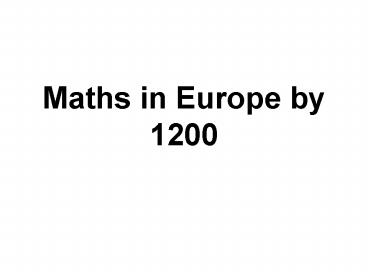Maths in Europe by 1200 - PowerPoint PPT Presentation
Title: Maths in Europe by 1200
1
Maths in Europe by 1200
2
- After the falling of the Roman Empire, Europe was
immersed in the chaos and anarchy, mathematically
speaking. - Europeans only began to wake up themselves from
the intellectual slumber (sleep peacefully or
comfortably) of the Dark Ages as they came in
contact with Arab civilization, mostly in Spain. - By 1200 the situation started to change.
3
- And now, for something completely different
- some of the most relevant mathematicians of this
time
4
Gerbert of Aurillac (940-1003)
- Became Pope and was known as Silvester II.
- Studied in Spain, where he learned the Indian
numerals (but no zero). - He wrote on arithmetic and geometry.
- One of the most difficult problems in his
Geometry was the following - Find x, y such that
- and
- This would have been an easy exercise for
Babylonian scribe!
Mathematical writings Libellus de numerorum
divisione,
De geometria,
Epistola ad Adelbodum,
De sphaerae
constructione and
Libellus de rationali et ratione
uti.
5
- Contemporary with Gerbert was another
mathematician and church-person, - Hrotsvita of Saxony (940-1002),
- who had an interest in perfect numbers.
6
Adelard of Bath (1075-1160)
- Was an expert in the Arabic language.
- Made three different latin translations of
Euclids Elements from Arabic sources. - Translated al-Khwarizmis astronomical and
trigonometrical tables. - Wrote arithmetic books.
- One of his most famous books is Quaestiones
naturales, which consists of 76 scientific
discussions based on Arabic science.
7
Abraham Ben Ezra (1095-1160)
- was born at Toledo and was called The Wise, The
Great and The Admirable Doctor. - was one of the most distinguished Jewish men of
letters and writers of the Middle Ages. - excelled in philosophy, astronomy/astrology,
medicine, poetry and linguistics. - also wrote various works on mathematical
subjects.
Main works about maths, astronomy and
astrology Sefer ha-E?ad, on the peculiarities of
the numbers 1-9. Sefer ha-Mispar, explained the
Hindu arithmetic, using Hebrew letters for
numerals, with a zero added. Lu?o, astronomical
tables. Sefer ha-'Ibbur, on the calendar. Keli
ha-Ne?oshet, on the astrolabe.
8
Gherard of Cremona (1114-1187)
- Travelled to Toledo to learn Arabic. He became
the most important translator of his time with
more than 80 works. - Was the first to translate Ptolemys Almagest.
- Translated Al-Kwarizmis first book on
algorithms Hisab al-Yabrwal-Mukabala.
9
Johannes de Sacrobosco (1195-1256)
- Was an English scholar who wrote an important
text on astronomy and promoted Arabic methods of
arithmetic and algebra. - In De Algorismo, discussed calculating with
positive integers. - His most important book is Tractatus de Sphaera
(the main book on astronomy until 17th century).
There, he discussed - a) The shape and place of the Earth within a
spherical universe. - b) Various circles on the sky.
- c) introduction to Ptolemy's theory of the
planets and of eclipses
10
(No Transcript)
11
Jordanus Nemorarius (1225-1260)
- His name does not appear in any list of clerics
so it is generally assumed that he was a layman. - wrote about triangles, circles, regular polygons,
Arabic numerals, primes, perfect numbers,
polygonal numbers, ratios, powers and
progressions. - was the first mathematician to correctly
formulate the law of the inclined plane. - His writings on geometry were important for
explorers who relied on the astrolabe for
navigation.
- used letters in place of numbers in his books on
mathematics, and was able to articulate general
algebraic theorems in this manner. However, his
system of algebraic notation was only a distant
antecedent to the algebra that is used today.
12
- There are six mathematical treatises written by
Jordanus - - The Demonstratio de algorismo, which gives a
practical explanation of the Arabic number
system. It deals only with integers and their
uses. - - Demonstratio de minutiis deals with fractions.
- - De elementis arithmeticae artis , a theoretical
work on arithmetic which became the standard
source of Middle Ages texts. - - Liber phylotegni de triangulis which is an
excellent example of a Middle Ages Latin geometry
text. - - The Demonstratio de plana spera is a
specialised work on geometry which studies
stereographic projection. - - Perhaps the most impressive of all is the De
numeris datis which is the first advanced algebra
to be written in Europe after Diophantus. - In this treatise he discusses problems of
the following sort - find x and y such that
-
and
- And another of this problems
This is the sort of problem the ancient
Mesopotamians were goot at.
If a given number is separated into two parts
such that the product of the parts is known, then
each of the parts can be found.
13
Ramon Llull (1235-1316)
- Llull used logic and mechanical methods involving
symbolic notation and combinatorial diagrams to
relate all forms of knowledge. This work makes
him a precursor of combinatorics.
14
William of Ockham
(1288-1348)
- Was an English mathematician who worked on logic.
- In Summa Logicae, he considered a three valued
logic where propositions can take one of three
truth values. - He also came very close to stating De Morgans
laws
Binary logic (Aristotle)
Ternary logic (Ockham)
Fuzzy logic (19-20th century)
15
- The mathematician who became to change the
situation of European mathematics was. - Fibonacci
- but this is a theme for other exposition.































